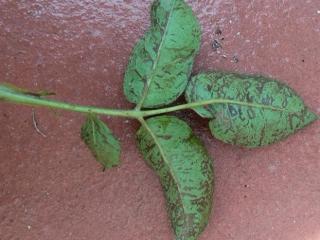Chilli thrips (Scirtothrips dorsalis) are found throughout the world and were first reported in north Western Australia about 20 years ago.
Chilli thrips are sap-sucking insects that can cause deformities in flowers, leaves, stems, and shoots.
Also known as strawberry, and tea thrips, chilli thrips feed on roses, all citrus and their hybrids, as well as a range of fruit and vegetable hosts.
Thrips are most active during spring, summer and autumn. In Perth, recent rainfall and humidity has created conditions that are conducive to chilli thrips, which feed on the sugars in new shoots.
In brief
Similar to: Western flower thrips (Frankliniella occidentalis), Plague thrips (Thrips imaginis)
Habitat: Deep in the flower or on the undersides of the leaves, and on the ground or lower leaves when pre-pupal or pupal stages
Hosts: Roses, all citrus and their hybrids, and a range of fruit and vegetable hosts
Monitoring: Look for chilli thrips when they are most active; in spring, summer and autumn
Damage: Distinctive brown scarring along the leaf veins, flower buds and the calyx or outer casing of fruit, light brown spots on leaves, curled and dried leaves, and deformed shoots or flowers
Lifecycle
The thrips lifecycle, comprising egg, larva, pre-pupa, pupa, and adult, lasts several weeks.
- Eggs are laid within plant tissues (eggs hatch more quickly in higher temperatures)
- Larvae emerge from the eggs feed on surrounding tissues
- Larvae fall to the ground or lower leaves when they reach the appropriate stage of development. They live there during the pre-pupal and pupal stages until a reproductive adult appears with fully developed wings.
Chilli thrips can have many generations in a single year and populations can build up over time.
Identification
- About two millimetres long
- Elongated, flat ‘torpedo’ shaped body
- Coloured pale or translucent to black
- Adult thrips have four feathery wings
- Very difficult to distinguish from other thrips species with the naked eye
Chilli thrips are difficult to see because they are small and hide deep in the flower or on the undersides of the leaves, which become silvery on the upper surface.
Damage
Thrips larvae feed on plant tissues and are responsible for the majority of plant damage.
- Early symptoms include a clear discoloration of the leaf with black dots (faecal secretions).
- Light brown spots on leaves, which may curl.
- In cases of very severe infestation, the leaves may entirely dry up.
- Wrinkled leaves with distinctive brown scarring along the leaf veins, flower buds, and the calyx or outer casing of fruit.
- Mosaic patches on plants, in which the top layer of the tissue is undisturbed and a window or clear tissue in evident. Chilli thrips cause this sucking up the liquid from plant cells; mainly from the leaves, but also the petals, shoots and fruits.
- Adult thrips also feed on the underside of leaves.
- Deformed shoots or flowers of affected plants, caused by toxic substances in the saliva of the pest.
Monitoring
Inspect plants regularly for evidence of thrips to enable early detection and minimise impact by the pest.
Monitoring is vital to enable the implementation of preventative measures when thrips are detected, because they are difficult to control once plant damage is evident.
- Use an adhesive trap (ideally blue since it attracts chilli thrips). Examine every few days using a magnifying glass to check whether chilli thrips (usually winged adults) have stuck to them.
- Tap flowers over a sheet of white paper and examine the black, torpedo-shaped 'specks' beneath a magnifying glass.
Management
Chilli thrips are difficult to control and public reporting indicates chilli thrips and other thrips species are prevalent across the Perth metropolitan region. The use of an Integrated Pest Management System is the most effective way to prevent chilli thrips infestations. Good garden hygiene to reduce the risk of spreading thrips and management activities include:
- Inspecting and treating plants to limit pest and disease spread:
- If pruning infested plants, bag cuttings to help reduce local spread to sections of the property that are not showing signs of the pest.
- Clean tools between plants, especially if cutting plants that looks diseased.
- Small populations may not cause sufficient damage to warrant chemical control but large infestations can seriously weaken plants.
- A range of products registered to treat other thrips species may be used.
- Preventative sprays may be required in some situations, such as to negate even small amounts of damage to blossom stems for show roses. Time preventative spraying to correlate with bud initiation.
- Products that contain active ingredients such as imidacloprid, acetamiprid, spinetoram, or pyrethroids are effective against thrips, and may be available to home gardeners.
- Horticultural soap, oils, and other products may be available as organic controls.
- Maintain good garden hygieneby cleaning up fallen leaves and debris. This reduces pupation and disrupts population buildup.
Always use products for management of thrips according to label directions.
Chilli thrips often hide under leaf veins and deep within flower petals, making it challenging to eliminate them without comprehensive coverage.
Multiple applications of treatments, whether organic or not, may be required and it may be wise to apply treatments to other nearby host plants to protect them from the pest. Take care when applying insecticides to conserve the beneficial predators that will help with thrips control.
Natural enemies of chilli thrip include Anthocoridae (pirate bugs), Phytoseiidae mites, ladybird beetles, certain parasitic wasps (Chalcidoidea), other predatory thrips, green lacewings and nabids (damsel bugs).
Reporting
Report unfamiliar and damaging pests for identification and distribution mapping.

More information
Thrips and sucking insects - botanical based registered products
Chilli thrips a burning issue for rose growers, 19 March 2021


